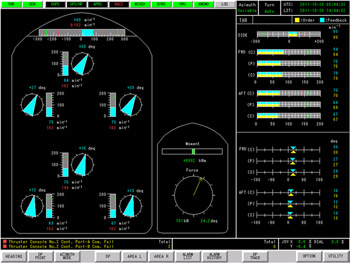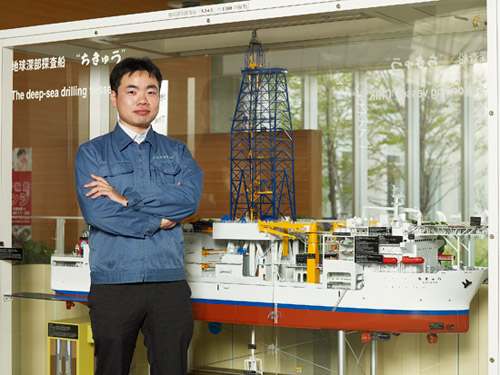Support from Land for Smooth Operation
 |
 |
|
DPS positioning information screen |
DPS thruster information screen |
The system needs a range of information in order to move the thrusters as required. This includes information on location, for which CHIKYU uses a satellite-based global positioning system (GPS) and an acoustic positioning system. Two systems are used for safety reasons. For example, if a solar flare knocked out the GPS satellite so that it could no longer receive radio signals, the vessel would need another way of obtaining location information. The acoustic positioning system works through transponders installed on the ocean floor. These bounce back signals sent out by the vessel and allow it to calculate its position. This mechanism is quite different from that used in a GPS, since it does not involve any exchange of signals with a satellite.
The hardware built into the DPS includes a wind vane, an anemometer, and a gyrocompass. Data from these instruments is processed by the onboard computer system and used to control the thrusters. During drilling tests in 2006 there was a gale with maximum wind speeds of 26.8 m/s, but even under these conditions the vessel maintained its position to within approximately 10 meters. The system can also control the inclination of the riser pipe used for drilling to within an operational tolerance of two degrees. This high degree of accuracy is indicative of the advanced technology used in the system.
The DPS is operated by navigation officers with specialized DP operator qualifications. Despite the huge size of the vessel, they need to be capable of making minute adjustments to its position, as the scientists deciding where to drill may ask for the vessel to be moved just a few tens of centimeters one way or another. When the DPS is holding the vessel in position, the DP operators keep watch on the DP console in the control cabin, or “bridge.” Monitors show a range of information, such as the vessel’s position and orientation, the external forces on the vessel such as wind and waves, the azimuth angle of the thrusters, and the operating status. They need to be constantly alert so as not to miss even the slightest abnormality.
Yamazaki and other personnel form a shore crew that carries out maintenance when the vessel is in dock and provides constant logistical support for operations when it is at sea. Thanks to this careful coordination on land and sea, the DPS has never once experienced any serious problems. CHIKYU’s safety is guaranteed by advanced equipment with doubled and redoubled safety measures, together with the careful operation by a highly professional crew.


- |1|
- 2|
